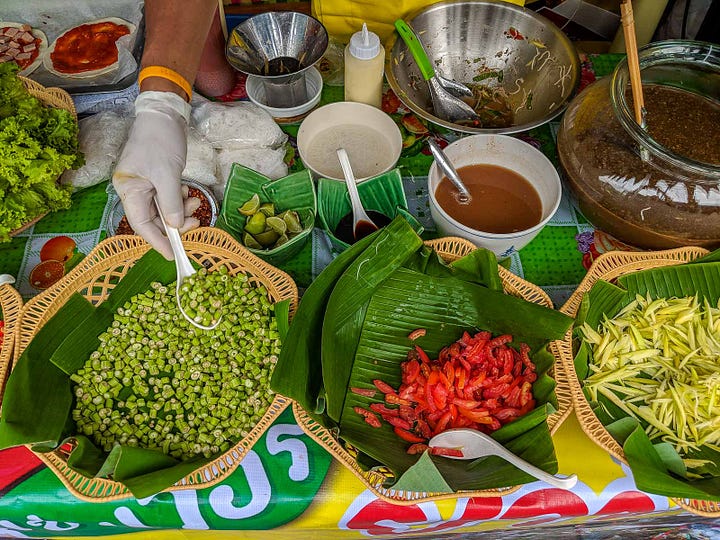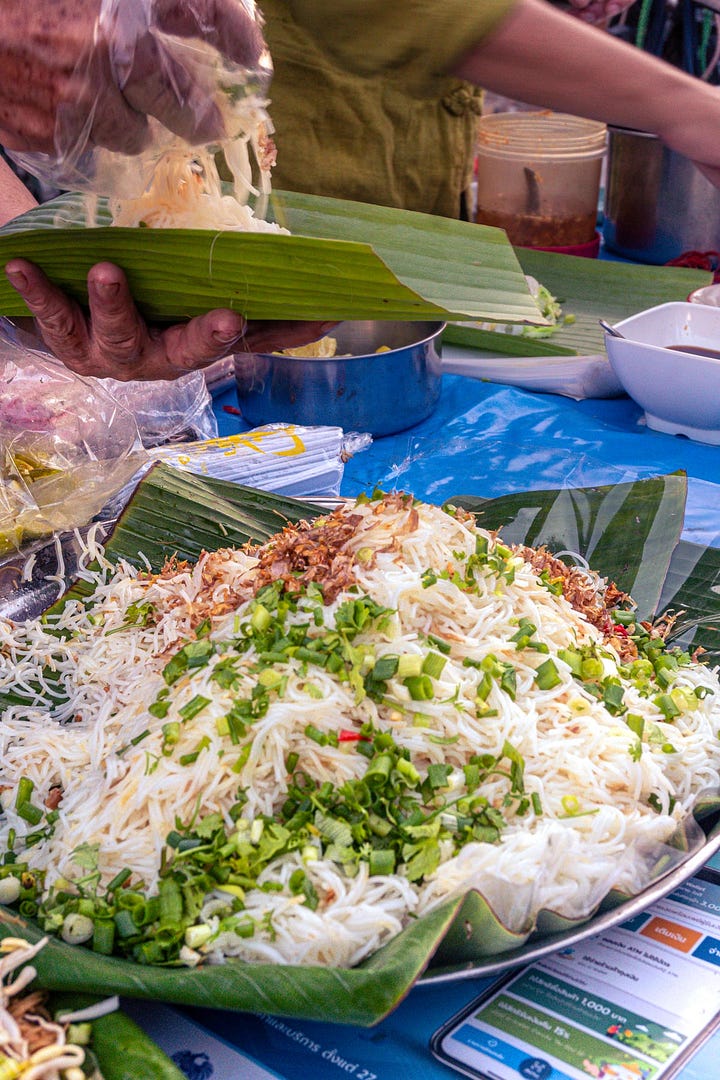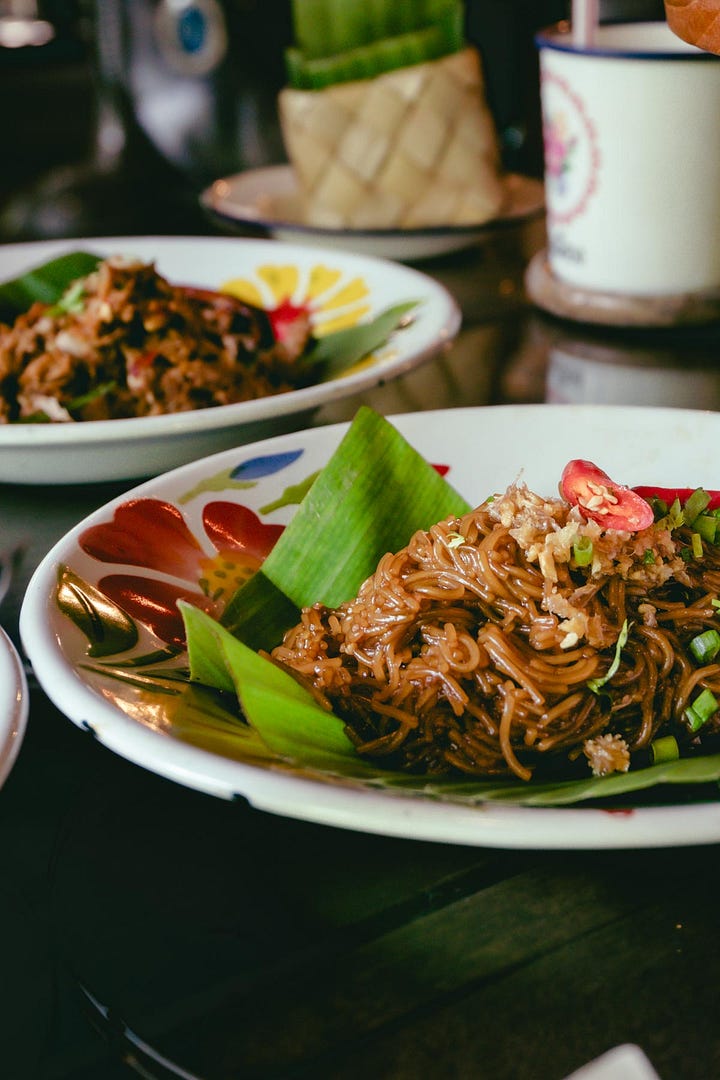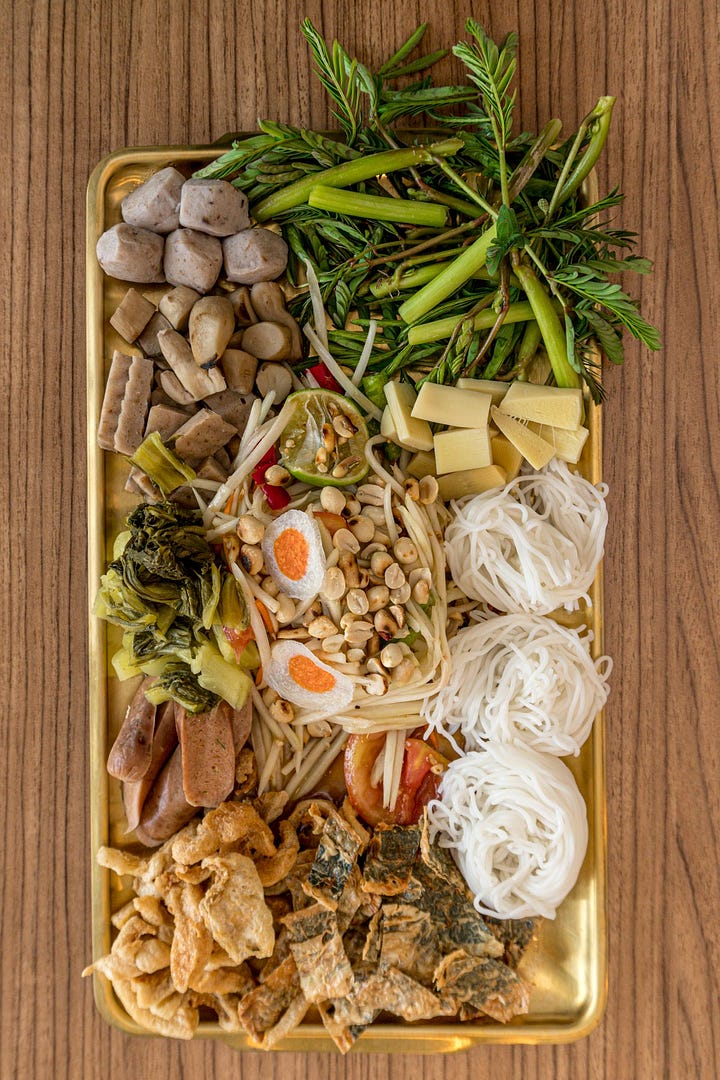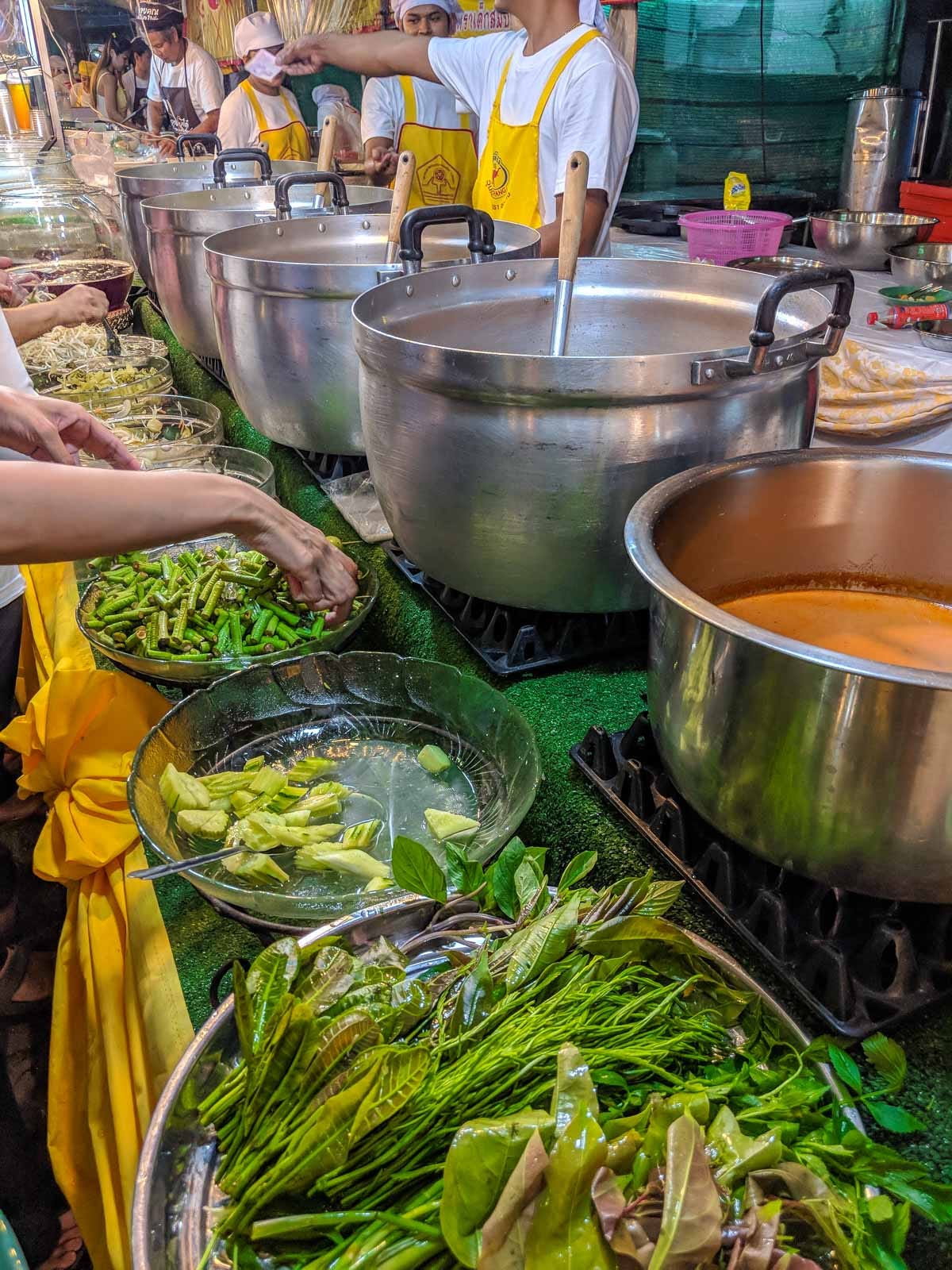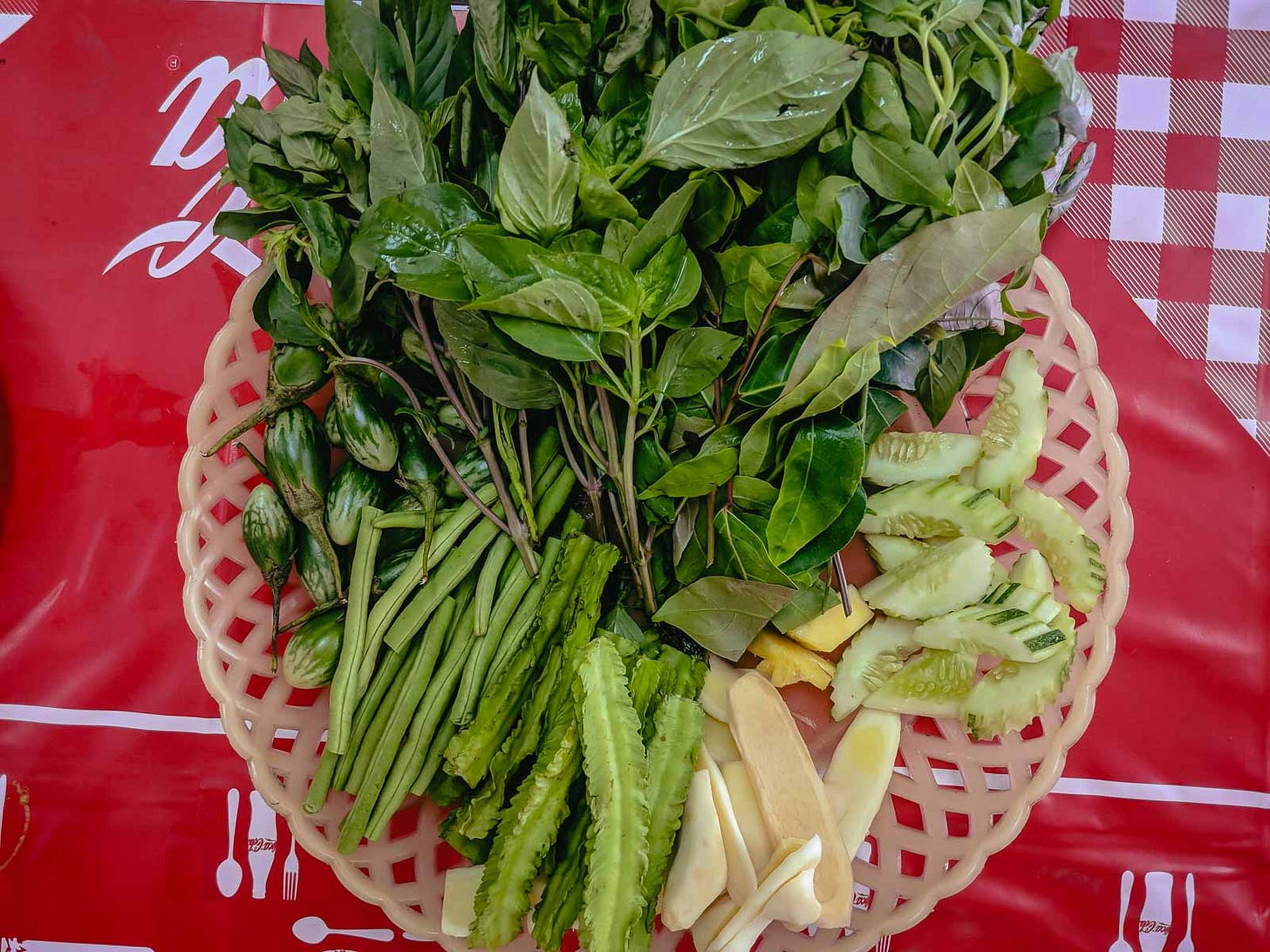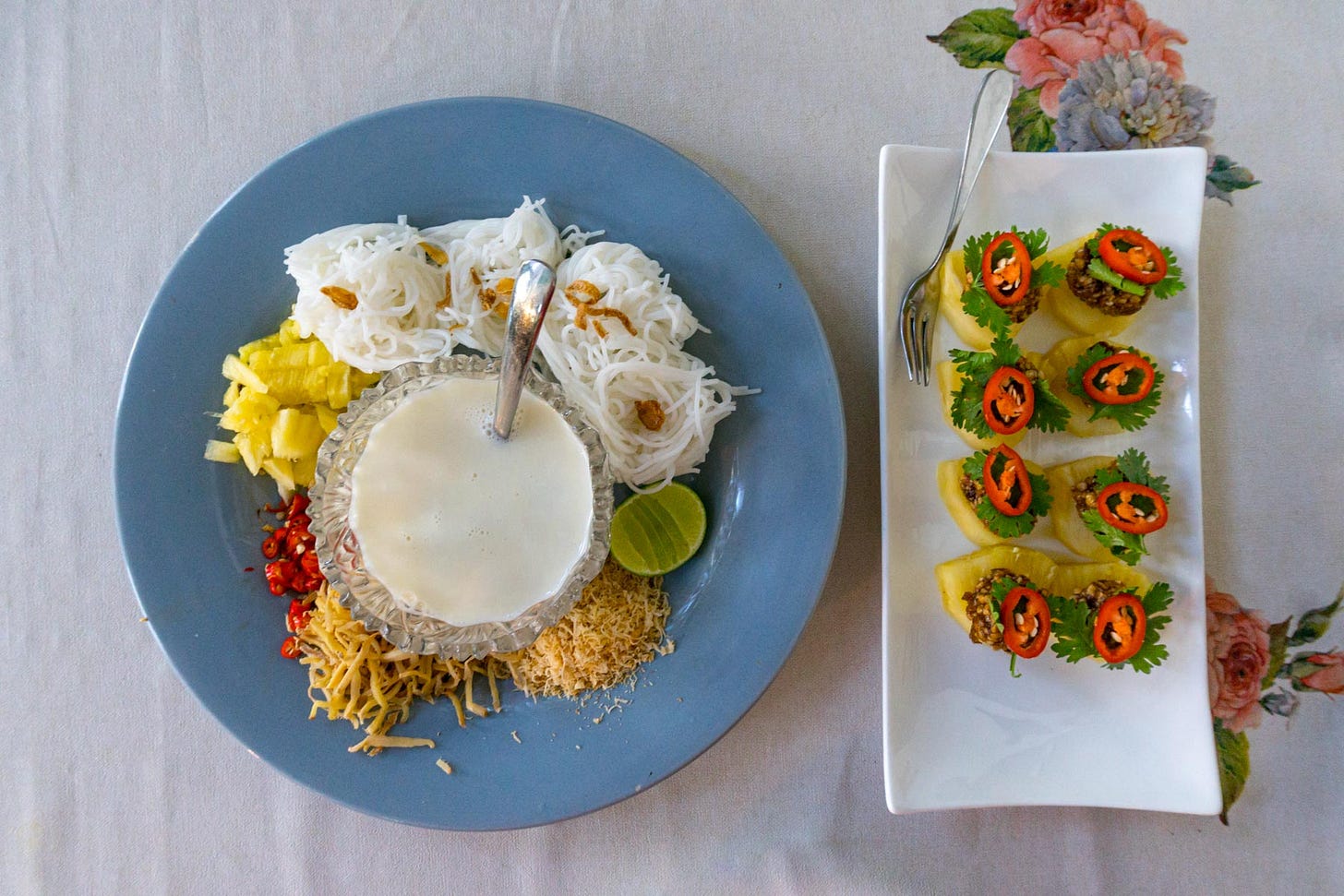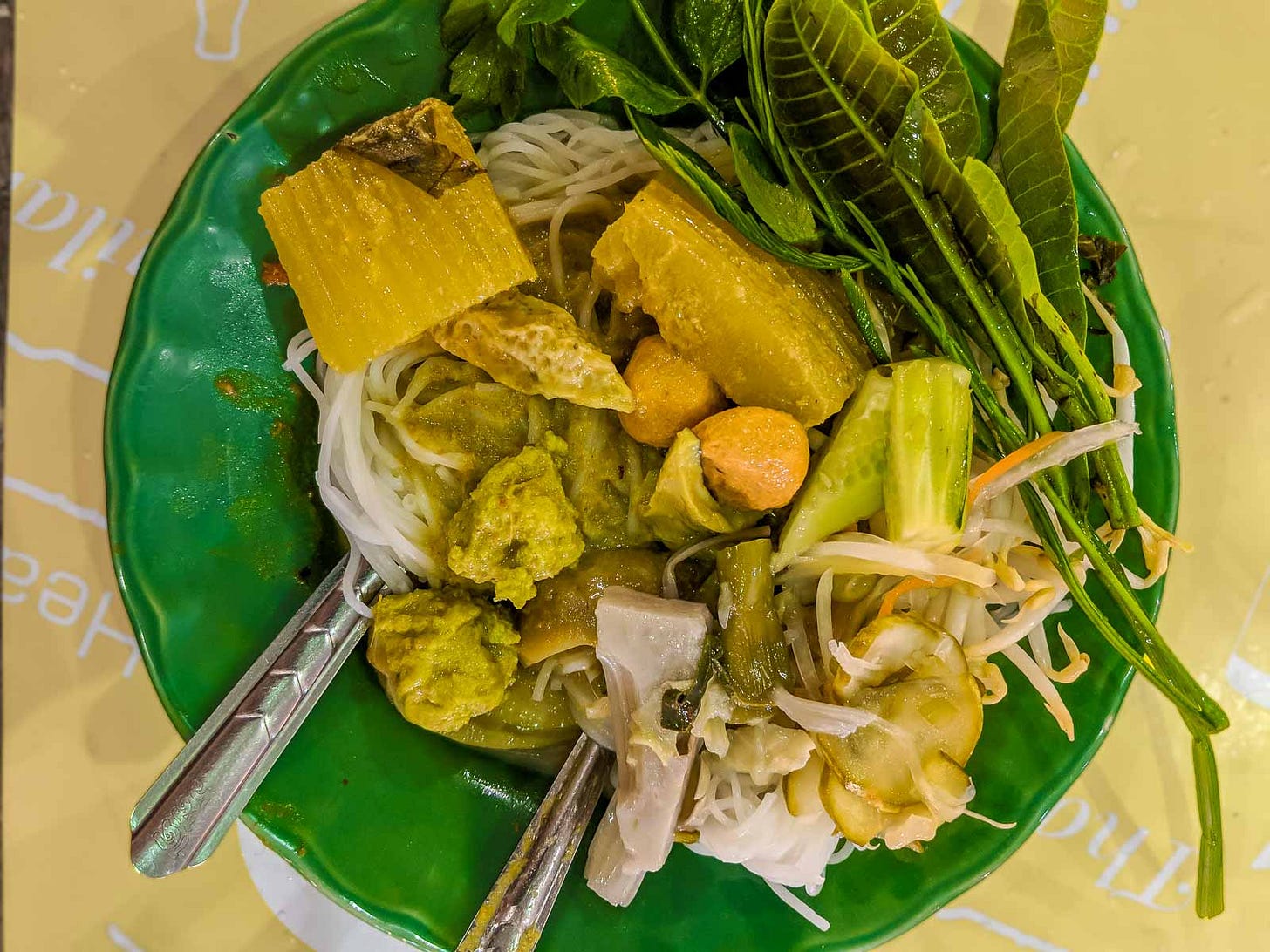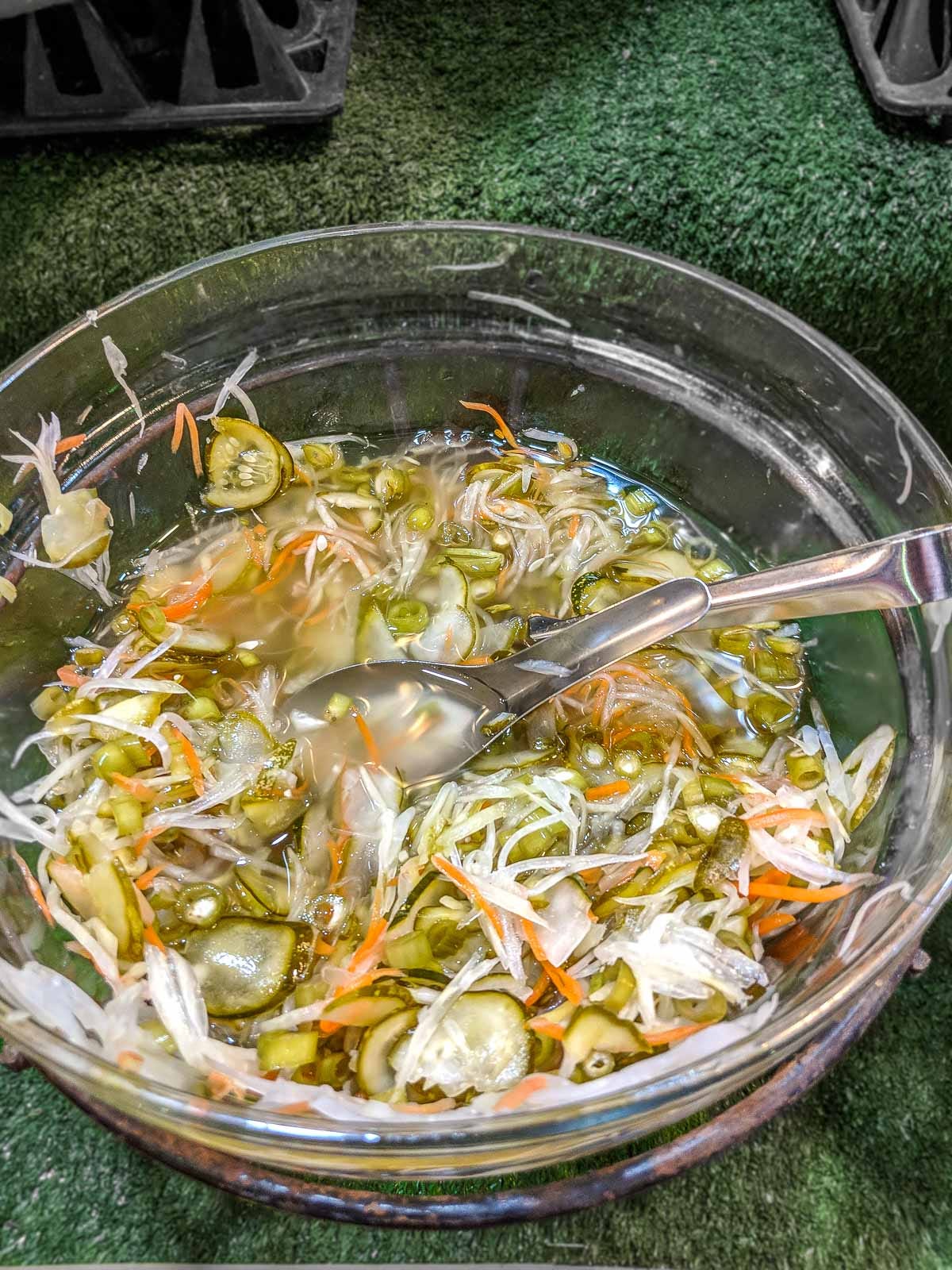Kanom jeen: curries and complementary toppings with Thailand's indigenous curry noodle
Curries, accompaniments, and regional variations
This is the second post in a series about Thailand’s native noodle. In part one, I talked about the history of kanom jeen and how the noodles are traditionally made. In this piece I’ll write about accompaniments and give an overview of popular curries by region.
The information in this post comes from a combination of dining experience, conversations with locals, and Thai cookery volumes. Much of the material with regards to regional preferences for vegetable accompaniments and sides (kruang kiang เครื่องเคียง), is referenced and translated from two Thai cookery volumes on kanom jeen pictured below.
Also, I acknowledge this is probably a very boring post and I’m okay with that because I’m mostly writing it to condense information in my own head. None of us are as unique as we like to think we are, so if this is something I’m interested in then someone else might also feel the same way. I’m fortunate enough to have the resources to figure this stuff out and I’m not going to gatekeep what I’ve learned.
As with any attempt to classify and sort cultural assets into tidy boxes, the information in this post is neither exhaustive nor standardised. When I speak of a herb or vegetable that’s common in one region or eaten alongside a particular curry, that doesn’t mean they are categorically restricted to one locale or dish. In reality the practices are flexible, which is unsurprising in a country where the eating culture allows for people to tailor foods to individual preferences without castigation from fellow diners (quite opposite to Britain, where you’ll achieve social pariahdom in one fell swoop of asking for ketchup with your roast potatoes).
One last note: as an ethical vegan I struggle with discussions of nonvegan items in my food writing because I disagree with taking anyone’s rights away in order to use their bodies. The good news is everything I mention below, from fermented fish entrails to pork rinds, has vegan counterparts.
Vegetable buffet with a side of noodles
Kanom jeen restaurants range from simple affairs offering a couple of curries with limited accompaniments to lavish spreads. In the South, where kanom jeen probably has cultural importance not far off that of pizza in Naples, there might be so many accompaniments that you’re full before you get around to trying them all. A friend from Nakhon Si Thammarat once described kanom jeen as a meal of vegetables with a side of noodles and curry. As a student with little money, she explained, she could fill up on unlimited vegetables for just a few baht. The noodles were a bonus.
Many food cultures employ herbs in food preparations, some more lavishly than others. "Westerners," Sally Butcher (of Persepolis fame) writes in her book Veggiestan: a Vegetable Lover’s Tour of the Middle East, “are wusses when it comes to herbs.”
In countries like Iran, Armenia, and others in the region, a stack of fresh herbs often accompanies a meal. Herbs are also treated in the same way as we would leafy greens, tossed into cooked dishes by the handfuls (e.g. Iranian kookoo sabzi and Georgian chakapulin). Meanwhile, Western publications are flooded with summer advice on how to handle a glut of mint.
Thailand also incorporates an abundance of herbs or vegetables treated as herbs into its foods, often as raw accompaniments. This is especially evident in kanom jeen shops, where you’ll find stacks of produce to dress your curry noodles. Hopefully I’ll illustrate the extent of this should you choose to read on (if you’re still here, thank you).
Regional variations of kanom jeen
To maintain consistency and avoid confusion, I refer to the noodles as "kanom jeen" throughout this text, though I want to point out there are regional terms as well.
North: kanom sen ขนมเส้น; khao sen ข้าวเส้น (in Tai Yai communities)
Northeast (Isan): khao poon ข้าวปุ้น
Central, South, and East: kanom jeen ขนมจีน
South: nom jeen หนมจีน
Kanom jeen is one Thai dish you’ll find throughout the country, but there are regional preferences with regards to both curries and accompaniments. And, since food is culture and culture doesn’t respect the silly borders we humans impose, there’s a lot of crossover. Many kanom jeen shops, no matter their location, offer favourites from across the country. Nam ya curry is a great example.
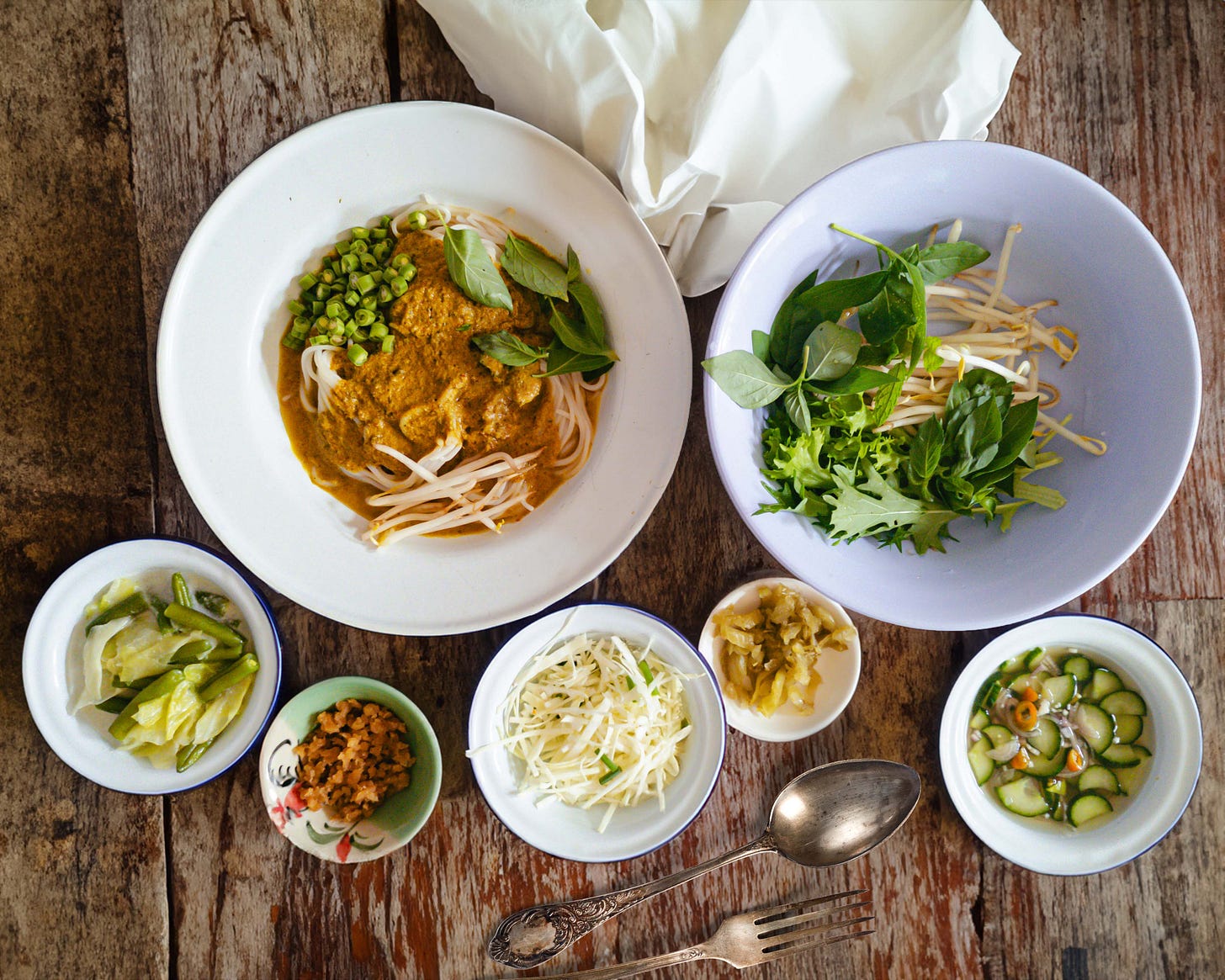
Nam ya, a texture red curry with blended fish (or mushrooms, if you go to any vegetarian restaurant in Thailand), is arguably the most well known curry served with kanom jeen noodles but its preparations change with its locale. In central Thailand, nam ya is a coconut milk based curry redolent with grachai (finger root), a pleasantly medicinal rhizome. In the South another underground stem rules the flavour profile: turmeric. Isan region omits coconut milk altogether in nam ya pa and grachai also features in the flavour profile. Isan versions also favour the addition of a fermented fish pasta called pla ra.
Let’s explore some other popular curries from different regions.
Northern Thailand ภาคเหนือ
You can also find nam ya in the North, but more common in this region is nam ngiao, a thin tomato-rich pig curry that has a uniquely funky flavour from tua nao, a local fermented soya bean product. The name is derived from a component ingredient called ngiao—the dried flowers of the cotton tree (Bombax ceiba)—though these flowers may not always be included in the dish, as there are district level sub regional variations as well. Typical accompaniments for kanom jeen nam ngiao include fried garlic oil, crispy fried dried chillies (and/or toasted chilli powder), bean sprouts, lime, coriander and spring onion, and pickled mustard greens.
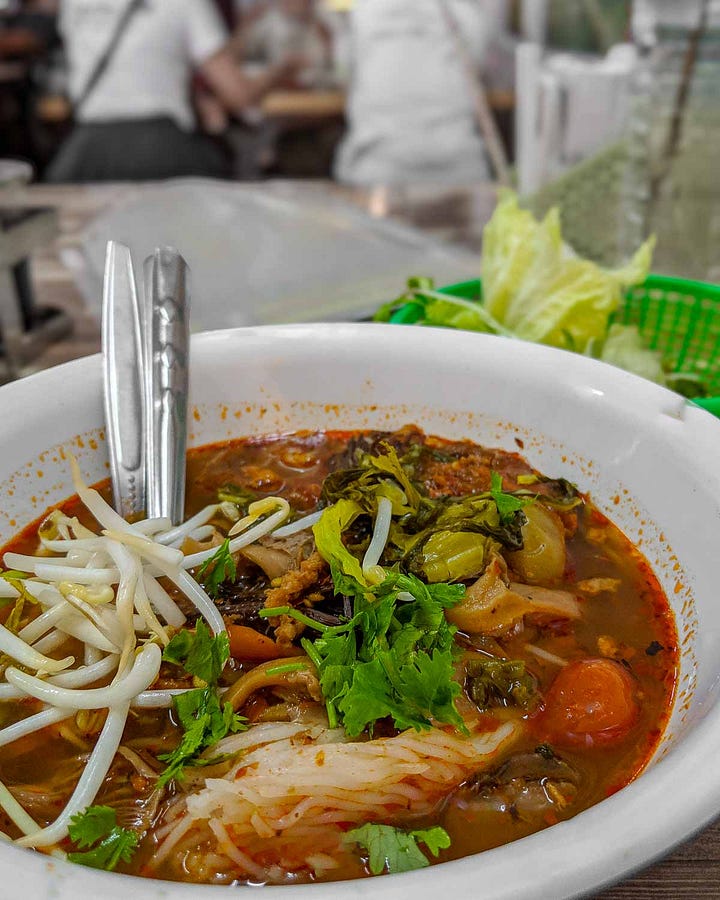
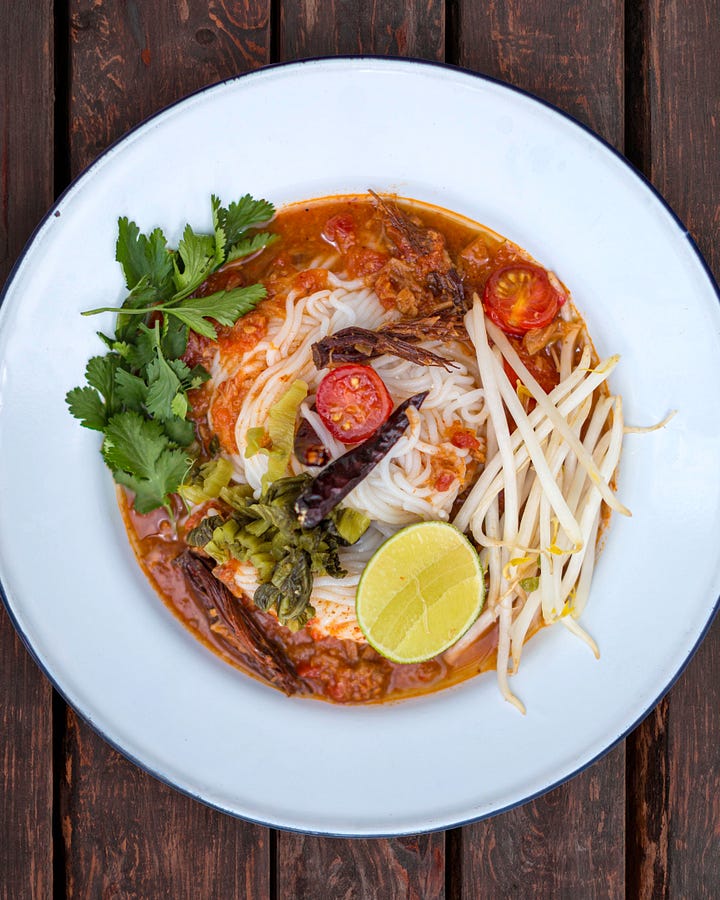
Incidentally, the word ‘ngiao’ is also considered a derogatory term for Tai Yai (native Shan Burmese) people in Thailand, which suggests the dish probably arrived with their migration starting in the 1800s.

And speaking of Tai Yai culture, there’s a nam ngiao adjacent curry I’ve eaten in Mae Hong Son called khao sen (after the local name of the noodle). This is a brothy curry, again umami-rich from tomatoes and pig, and a little funky from the addition of tua nao. Common toppings include pork rinds, bean sprouts, coriander and spring onion, MSG, salt, fried garlic oil, lime, and toasted chilli powder.
Another curry, although more typically eaten with rice, that you might find with kanom jeen is gaeng hanglay. This dish has Burmese origins and ranks among the top five tourist-in-Chiang-Mai favourites. While the recipe can vary from town to town, the universal ingredient is a Burmese (by way of India) masala spice blend.
Central Thailand ภาคกลาง

Back to central Thailand, another popular curry served with kanom jeen is nam prik. Not to be confused with the culinary category of chilli relishes by the same name, nam prik is a rich and smoky coconut curry with a nutty flavour from toasted mung beans (though nowadays vendors are as likely to use peanuts, which require less preparation time). A sour ingredient like tamarind or lime juice goes in at the end to balance the sweetness, but in the wild this curry is often too heavy on the sugar and not balanced enough with acidity.
It’s not unusual to mix nam prik and nam ya curries together.
Then there’s one everyone knows: green curry or gaeng keow wan.
Popular accompaniments and sides
In central Thailand, kanom jeen accompaniments are called muuat เหมือด.
Fresh vegetables might include shredded banana blossom, long bean, cucumber, young papaya, lemon basil (especially delicious with nam ya), Thai basil, bean sprouts, shredded cabbage, water mimosa, pennywort, and more.
Blanched vegetables might include things like bitter gourd, morning glory, lotus stems…
Tempura vegetables are sometimes served with kanom jeen nam prik, especially in higher end restaurants, and might include wild pepper leaf (bai cha plu ใบชะพลู, sometimes confusingly called betel leaf), morning glory leaves, and a variety of flowers (including butterfly pea).
Pickled mustard greens are almost always present. You might also find fried dried chillies and boiled eggs.
Kanom jeen sao nam is a central dish I consider to be a little bit of an outlier with regards to the kanom jeen canon. My reasoning is twofold: first, the accompaniments are relatively fixed, meaning this dish typically arrives at the table with all its components included. Second, it’s usually a very seasonal dish. Especially popular during the hottest months of April and May, kanom jeen sao nam requires minimal cooking and instead relies on high quality fresh ingredients. The noodles are accompanied by tangy-sweet chopped pineapple, thin slices of fresh garlic, julienned young ginger, rich coconut cream, sliced fresh chillies, eggs, dried shrimp, fish balls, and lime. You might also find green mango and white turmeric on the plate.
Northeastern Thailand (Isan) ภากอีสาน
As mentioned, this region has its own variation on nam ya, a jungle style curry sans coconut milk. Pla ra, a fermented fish product, tends to feature. Some popular vegetable accompaniments include:
Young hog plum leaves (yod magok ยอดมะกอก)
Young Indian oak leaves (yod jit ยอดจิก)
Mampat leaves ( pak diu ผักติ้ว)
Dill (pak chee lao ผักชีลาว)
Water dropwort (pak chee lom ผักชีล้อม)
Rice paddy herb (pak kayang ผักขะแยง)
Vietnamese coriander/laksa leaf (pak pai ผักไผ่; pak paeo ผักแพว)
Various bits from horse tamarind trees, including young leaves (yod gratin ยอดกระถิน), young seed pods (fak gratin on ฝักกระถินอ่อน), and the more mature seeds (met gratin เม็ดกระถิน)
Young Climbing Wattle leaves (cha om ชะอม)
Southern Thailand ปักษ์ใต้
Kanom jeen is serious business in the South, where both curries and accompaniments are sometimes so vast I’m unable to try everything in multiple visits.
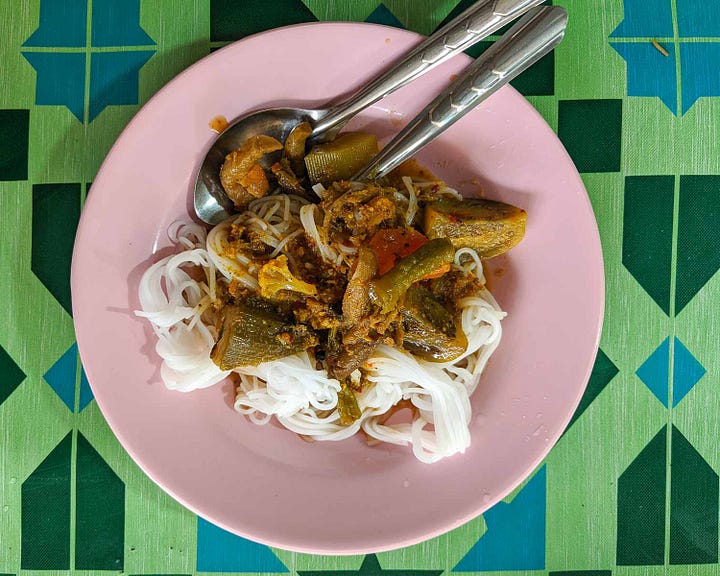
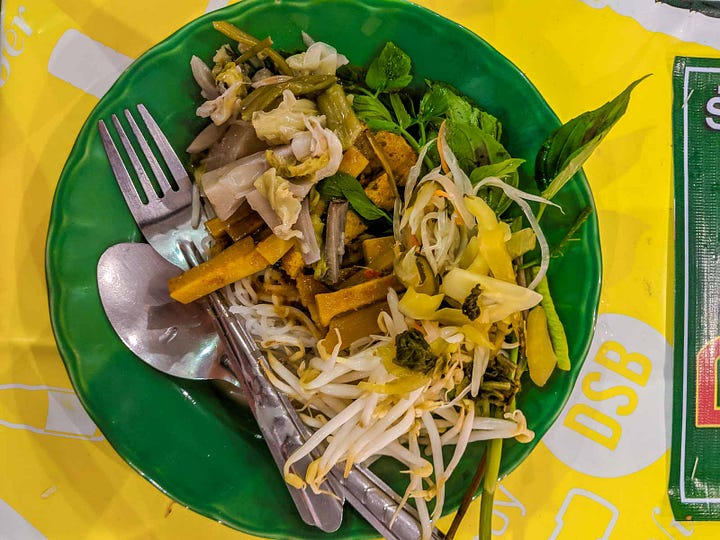
In addition to the very popular local version of nam ya, Southerners also enjoy a particularly funky and overwhelmingly spicy curry known as gaeng pung pla in the local dialect or gaeng tai pla elsewhere. Vegan versions of this fermented fish entrails curry abound, especially during the annual vegetarian festival. Vegetable add-ins vary, but whole cashews are a typical addition in the South. This curry can also be found in Bangkok, where it’s likely less spicy and often includes vegetables like pumpkin, bamboo shoots, long beans, and eggplant.
Green curry is also not uncommon, but it differs from the central style in that it includes fresh turmeric in the curry paste.
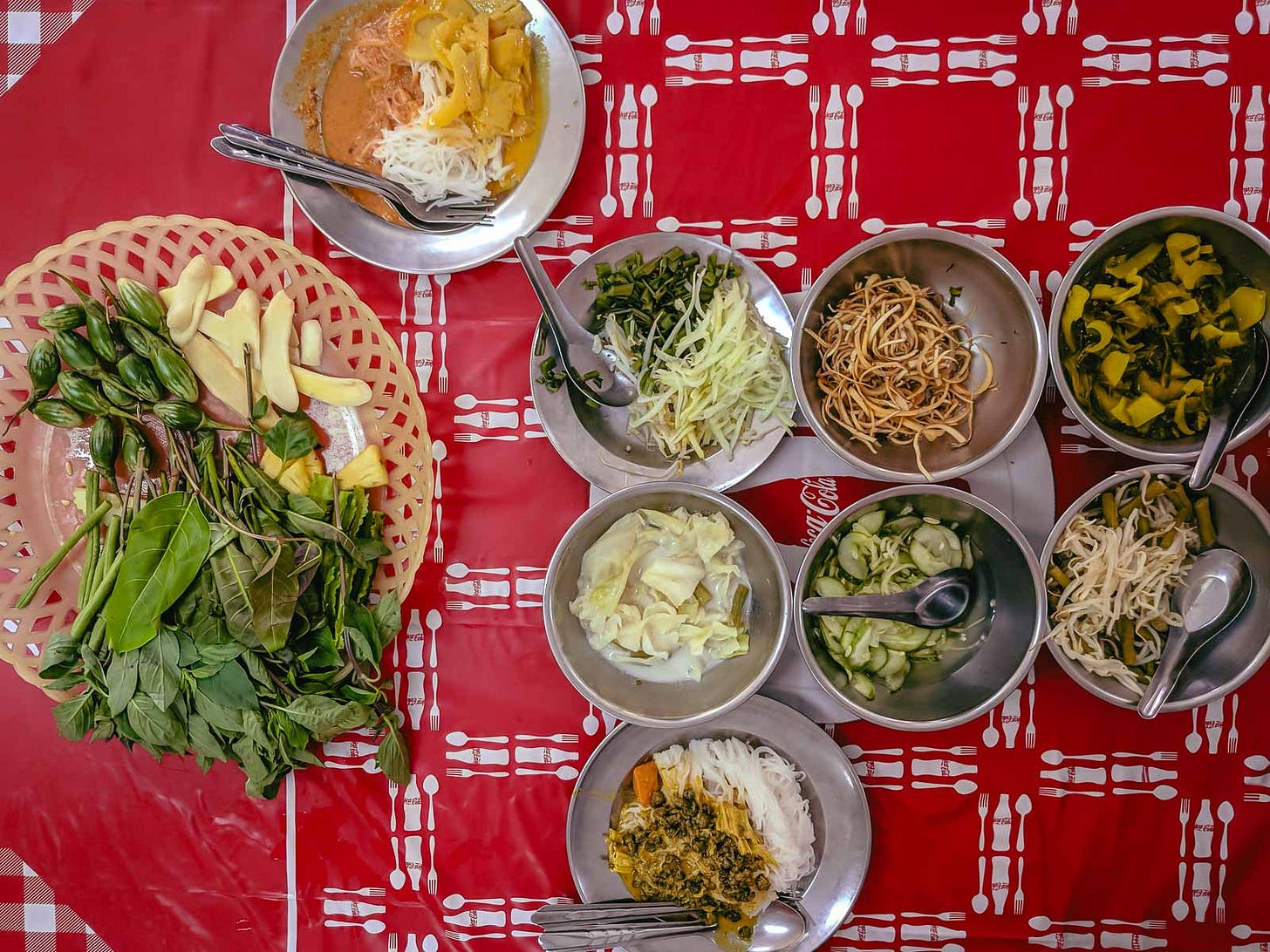
Common accompaniments and sides in the South
A not at all exhaustive list of popular vegetables (called pak noh ผักเหนาะ in the South) include:
Young shoots/leaves of Glochidion Wallichianum tree (yod man puu ยอดมันปู)
Cashew tree leaves (bai mamuang himapan ใบมะม่วงหิมพาน; bai hua krok ใบหัวครก)
Young hog plum leaves (yod magok ยอดมะกอก)
Young leaves of the Litsea Elliptica tree (yod tammang ยอดทำมัง)
Stink beans/petai (สะตอ sator)
Jenkol beans (ลูกเนียง luk niang)
Fruit of Ficus Botryocarpa Miq. (luk ching ลูกฉิ่ง; dua ching เดื่อฉิ่ง)
Horse tamarind pod seeds (met gratin เม็ดกระถิน)
Water dropwort (pak chi lom ผักชีล้อม)
Asian pennywort leaves (bai bua bok ใบบัวบก)
Water mimosa (pak grachet ผักกระเฉด)
Thai/apple aubergine (makua pra มะเขือเปราะ) plus other types of aubergine as well
Cucumber, bean sprouts, long beans, winged beans…
In addition to fresh vegetables, various pickles are common in South. If you’ve ever had ajat, the sweet and sour cucumber relish consumed with satay and some rich Muslim style curries, that’s the flavour profile. These pickles are made by simmering vinegar, water, sugar, and salt to dissolve and then adding vegetables such as cucumber, shallot, green papaya, bean sprouts, the aforementioned luk ching, and young jackfruit.
Other pickles include sweet preserved radish (an integral ingredient in pad thai), pickled mustard greens, and pickled bamboo.
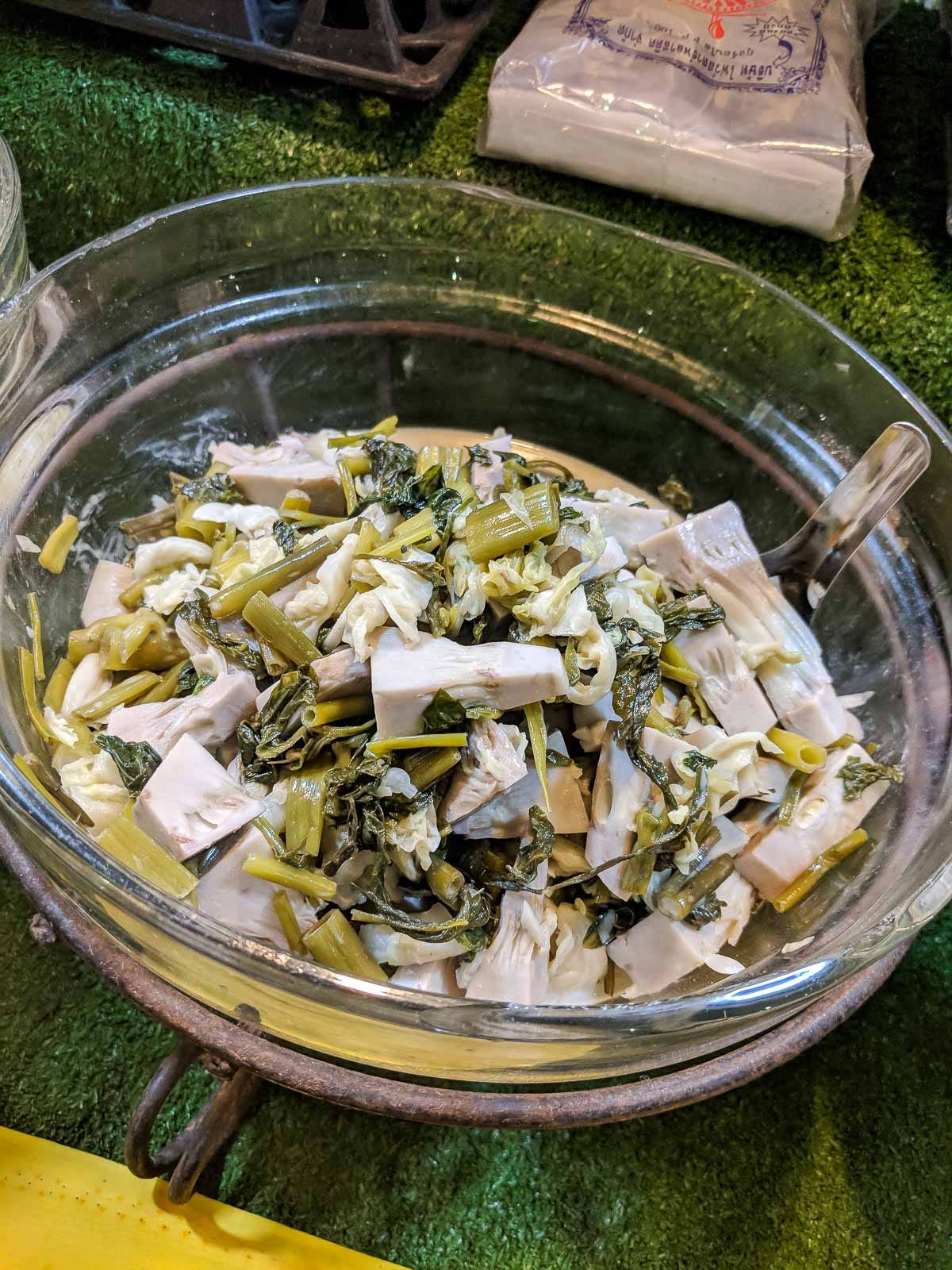
And finally there’s the vegetables simmered in coconut milk, which help to offset the fiery chilli heat present in much of Southern cuisine. Options here include veg such as morning glory, cabbage, shredded banana flower, young jackfruit, lotus stems (lai bua สายบัว), and more.
Other kanom jeen dishes
While kanom jeen is typically served with curry, there are exceptions to the rule. There are plenty of other Thai dishes that utilise these thin extruded noodles as an ingredient, like tam sua ตำซั่ว (som tam made with a roughly even balance of green papaya and kanom jeen) and pad kanom jeen ผัดขนมจีน (stir fried kanom jeen). Kanom jeen also feature in other salads, ranging from your standard yum style dressing of lime, sugar, and a salty element to Northern profiles hefty with fried garlic oil, fresh spring onion and coriander, salt, with a distinct lack of acidity (e.g. khao sen ko ข้าวเส้นโก้).
